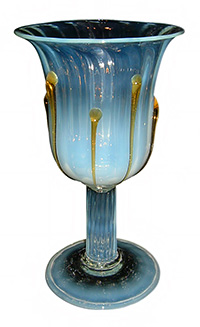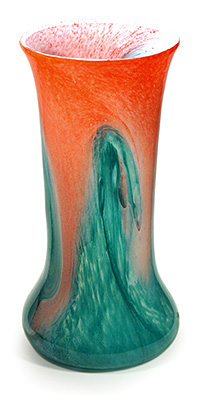
Gray-Stan goblet vase, featuring applied amber tears around the bowl. The foot, stem and bowl are all blown in a rib mould & the foot is folded up and over in the Venetian manner.
Image courtesy of Basil Loveridge.
The May 2013 National Glass Fair will feature another exciting exhibition of significant glass. This time around we will be showcasing the work of Gray-Stan glassworks.
The exhibition has been curated by veteran glass collector Basil Loveridge and features outstanding and noteworthy examples of Gray-Stan art glass. All of the items are from Basil's private collection and this exhibition will be the first time glass from this particularly important collection have been brought together and exhibited in public. In fact this will be the first time there has been an exhibition dedicated solely to the glass of Gray-Stan.
About Gray-Stan Glass
Gray-Stan was a small UK glass factory that burnt fast and bright for a mere 10 years (1926-1936). The company was established by Elizabeth Graydon-Stannus: an Irish antique glass dealer, ambitious entrepreneur and self assured business woman. Mrs. Graydon-Stannus set up business in 1926 on Battersea High Street (London) bringing with her a team of Irish glassmakers that had been recruited a year prior to Gray-Stan opening for trade.
Rallying against the uniformity of mass production, Graydon-Stannus set down a workshop philosophy that championed individual creativity and artistic freedom. Bucking the trend towards industrialisation, she saw technology as the enemy of individuality and even went as far as to banish machinery of all kinds from the factory. Necessarily every item of glassware had to be completely hand made - something that was both a badge of honour and a shrewd bit of marketing. Proud of this artisan ethic and the level of craftsmanship that went into each product, Graydon-Stannus ensured that all the glass produced in her factory was signed (either 'GrayStan' or 'Gray-Stan').
Over the years Gray-Stan maintained a relatively small team of glassmakers (ranging from 12 to 30). These glass artists were spearheaded by chief designer Noel Billinghurst and head glassmakers George Hollins and James Manning. Encouraged by Graydon-Stannus they strove to be as innovative as possible and were granted a great deal of creative freedom. This autonomy enabled Billinghurst, Hollins and Manning to develop a diverse and interesting range of different product lines.
Although clearly influenced by the glass produced by other manufacturers, Gray-Stan was able to put their own spin on things and create glass that had a distinct identity which set them aside from the competition.
Of all the lines produced by Gray-Stan, it is perhaps best known for its range of impressionist-inspired art glass (pictured left and below). This type of glassware was extremely labour-intensive and was created by first rolling molten clear glass onto a bed of white enamel and coloured powders that added expressive swirls and bands of colour. These colours were often further manipulated on the surface of the hot glass before being cased in a layer of clear glass.
Victims of the 1930s economic climate, Gray-Stan ceased trading in 1936. Despite only trading for ten years the company has left us a legacy of decorative collectable glass that still remains popular with connoisseurs of antique art glass.
Basil Loveridge
Tall cylindrical 1930s vase with swollen base and everted rim
- typical of the Gray-Stan production.
The swirled, marvered colours of turquoise blue and red
are applied over a background base of opaque white.

Basil first became interested in collecting glass around 1980, but as with most novices, he began in a rather haphazard and indiscriminate way. Initially he collected anything from Georgian glass through to contemporary studio glass.
Gradually Basil's tastes developed and he began to find English glass especially appealing: particularly glass from the 19th and early 20th century.
It was after visiting the superb 1987 exhibition ‘British Glass Between The Wars’ (held at Broadfield House Glass Museum) that Basil became aware of this tremendously creative period in glass design. In particular the glass created by James Powell and Gray-Stan made a lasting impression.
Whilst there was a great deal of interest in Powell glass in the 1980s, notably their 19th century glassware, Gray-Stan was something of an unexplored field and provided a fruitful field to explore and collect.
This Gray-Stan exhibition represents the cream of the collection Basil has amassed over the last 20 years. It is likely that the collection will be broken up and sold off in the near future, so this exhibition may be the last opportunity for collectors to view this collection in its entirety.





